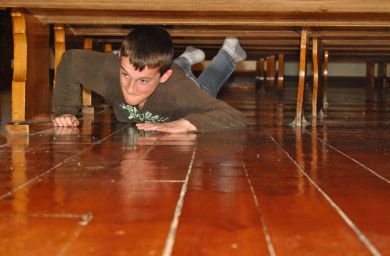An interesting article by Christianity Today posing wether or not we should value the Syrian Christians fate over the fate of the entire nation.
Daily Archives: September 13, 2013
Protestants and the Temple
“Protestants love to read the story of mount Sinai and the giving of the law, and then they close their Bibles. ‘We’re done’” -Dr. Stephen Reid
Its been my experience that this statement is spot on. But why? When one begins to delve into the story and history of the tents and tabernacle in Exodus and beyond, an amazing lineage of the dwelling place of God is uncovered. Lets think about that phrase for a second. “The dwelling place of God.”
We grow up being told in Sunday School that God is everywhere. With the introduction of Christology we get an even more vague understanding of this concept when we learn that Jesus himself lives “in our hearts.” This stands in blatant contrast to Old Testament understanding of the locale of Yahweh. The people of Israel knew that God had a very literal house which stood as the place in which the physical manifestation of the Lord resided. Whether this place was a tent, tabernacle, or temple, there was an idea of sacred and holy space that was as serious as a heart attack. (I’m not sure how it happened but I assume that could be one of the causes of death when entering the holiest of holies). Even when the holiness of God was riding around in a box, Uzzah was struck down for trying to steady the ark of the covenant when the oxen carrying it stumbled (2 Samuel 6:6-11).
In the short 8 years that I have been in ministry, I have seen the Sanctuary of churches used for everything from games of sardines and pew races to rummage sale storage units. I think its safe to say that we no longer fear the smiting hand of the Lord when it comes to holy spaces. But then again, why should we? When Jesus died, the giant veil that encloses the holiest of holies was torn in two and the presence of God is spilled out into all the earth (Matthew 27:51). There no longer stood a barrier between God and his children. The death of of our High Priest Jesus bridged the gap.
So where are the sacred spaces in our modern protestant church? Where are our holiest of holies, our ebenezers, our sanctified spots? I would argue that this idea is not completely lost, but it has changed forms so radically that it can often times be hard to recognize. In his blog titled “Mostly for Baptists (Others can Listen in): Priesthood of Believers,” Roger Olsen explores the theology behind this cherished Baptist belief. He ties his understanding of the doctrine to the original Levitical priests as mediators between the people and God. After the tearing of the veil and the indwelling of the Holy Spirit, all believers have become members of this priestly class.
This is interesting because I think it is a place where we begin to see the notion of temple theologically shift from a building to the hearts of every believer. But if this is true, we are forced to look at the implications this has on our lives. The question becomes, how are we taking care of the temples we have erected. Here I could insert passages about guarding your heart (Proverbs 4:23) or your body being a temple (1 Corinthians 6:19), but rather than pose the question of how we treat these internal tabernacles, I would ask about how we think about them. What parts of our lives are held separate and reserved? Where are the sacred spaces, times, ideas, words, etc.?

